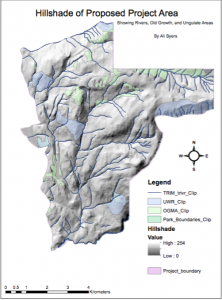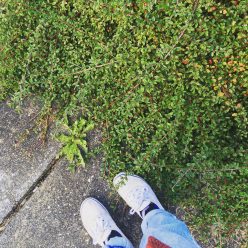I learn best when I can see the direct results of my work, which is one of the reasons why I find working with GIS rewarding. I am able to see the results of my work in the form of a map. I’m continuously surprised at the pride I feel in relation to even the simplest of maps when I am the mapmaker. The quality of my maps improved over the course of these past months, but there is still lots to learn.
Assessment of Northern BC Pipelines
This study analyzes two pipelines transporting Liquid Natural Gas (LNG) across Northern BC to the coast. The location of these pipelines affects a number of species at risk and First Nations populations. 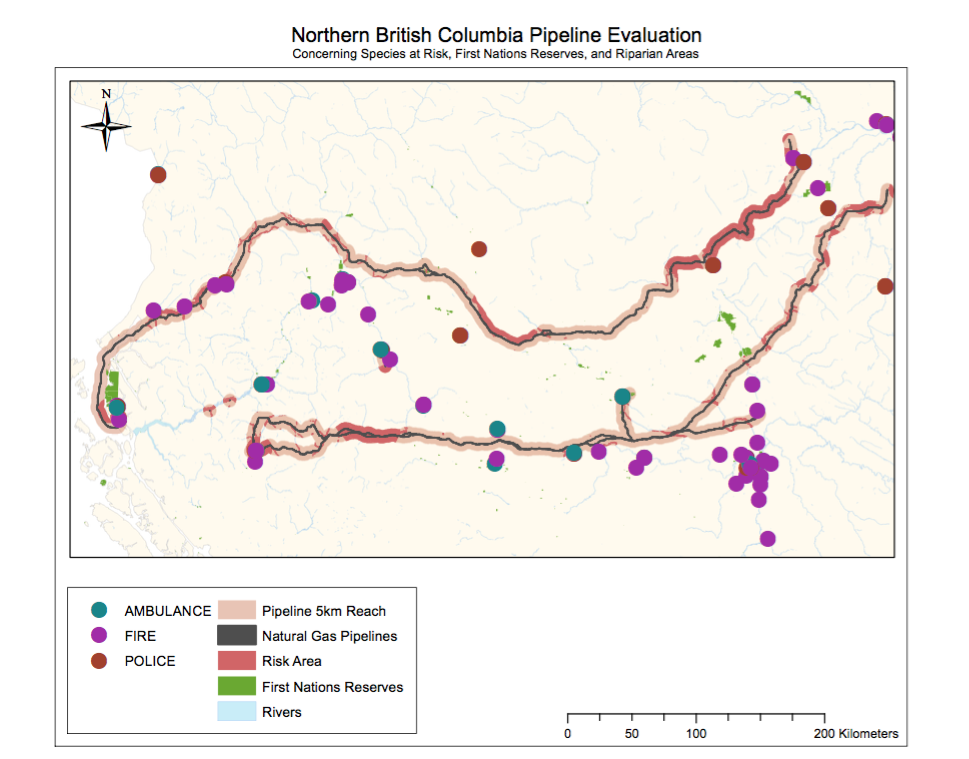 Additionally, we chose to include the location of all first responders in the area to determine the safety of these communities. We established a 5-kilometre buffer zone around the pipeline to account for the reach of any type of spill. The goal of this study was to determine who is most affected by the location of these pipelines and establish an understanding of the situation of these pipelines. This was accomplished through a series of analysis using ArcGIS to create 3 maps, each emphasizing a different aspect of the project. The first shows all the elements previously discussed like First Nations communities, First Responders, Species At-Risk, and the pipelines. The second and third maps are intended to highlight the biological and social implication respectively.
Additionally, we chose to include the location of all first responders in the area to determine the safety of these communities. We established a 5-kilometre buffer zone around the pipeline to account for the reach of any type of spill. The goal of this study was to determine who is most affected by the location of these pipelines and establish an understanding of the situation of these pipelines. This was accomplished through a series of analysis using ArcGIS to create 3 maps, each emphasizing a different aspect of the project. The first shows all the elements previously discussed like First Nations communities, First Responders, Species At-Risk, and the pipelines. The second and third maps are intended to highlight the biological and social implication respectively.
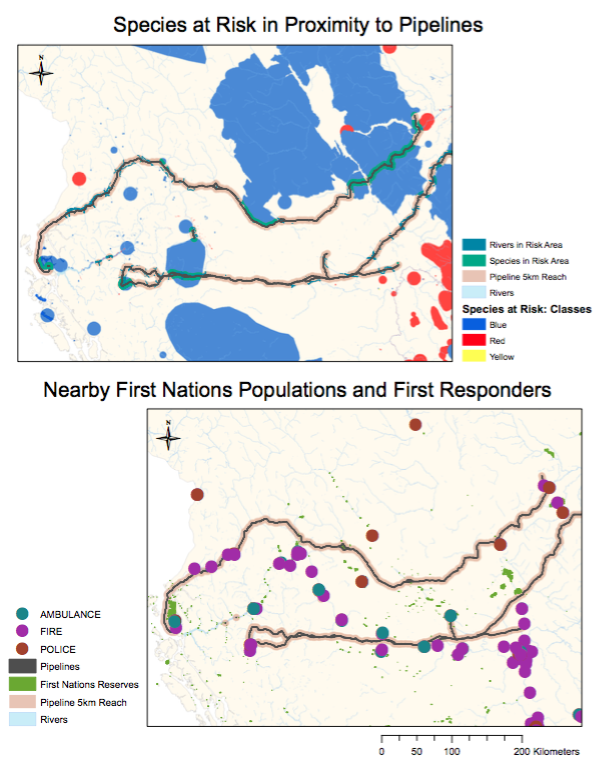
We conducted all of the analysis as a group of three sitting around one computer working on one map. I found this very useful because each of us was able to share at least one skill or trick with the group. It facilitated the process of creating a map completely from scratch. I learnt a lot about the value in working together because it allows you to examine things from an angle you might not otherwise consider.
Environmental Impact Assessment: Garibaldi at Squamish
The Garibaldi at Squamish is a proposed development project for a year-round resort 15 km north of the town of Squamish. There main focus of the resort is a ski hill. According to the plans it would take 20 years to build and create 900 construction jobs during development and 2500 service jobs after completion. There is some concern over the economic viability of the resort due in part to chancing climate and environmental conditions. Since 1974, it has been reported that skiing under the elevation of 555m above sea level is no longer viable due to the changing climate. Given current day understandings of climate change, this number has been increased to 600m. I am a natural resource planner hired by the BC Snowmobile Federation to examine the Environmental Assessment’s recommendations and Whistler’s criticisms to evaluate  whether or not I can condone this project. Currently, I am opposed to it, but perhaps this analysis will prove support the project’s development. To determine whether or not this project is a viable option in term of the surrounding environment I will analyze available data using GIS software.
whether or not I can condone this project. Currently, I am opposed to it, but perhaps this analysis will prove support the project’s development. To determine whether or not this project is a viable option in term of the surrounding environment I will analyze available data using GIS software.
To conduct a complete environmental assessment we must take into account the species living in the proposed park area, the elevation scheme, the distribution of fish-bearing streams, and the presence of old growth forest areas. All of this data can be found on the province of BC’s website. I found layers of data related to old growth forest management, species winter habitat range, endangered species, river systems, and elevation as well as the park boundary coordinates. I delineated all the layers using the park boundary to only show information relevant to the park. I then sorted the data to obtain the areas of each consideration in question. For example, I calculated the percentage of old growth regions in the park. The total percentage of the area of the park affected by the various environmental factors is 46.5% and out of that 31.8% of the land is below 600m. Give than quantity of land below 600m combined with the amount of red-listed species and old growth management that 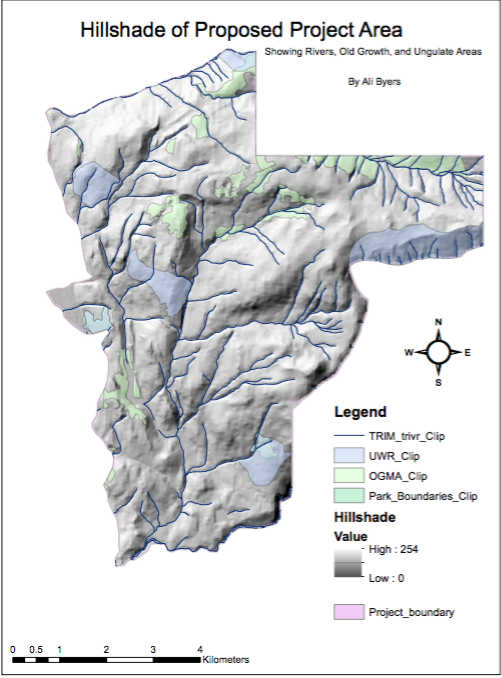 would be affected I can’t condone the development of the project. Economically it wouldn’t be viable because there isn’t enough land to ski on. In my opinion, the elevation and the lack of sufficient snow for skiing is the greatest environmental concern. Second to that is the disappearance of endangered species habitats. In my opinion, these are the most important environmental factors. Unfortunately there is no way to mitigate the elevation however; the red-listed species could be put in protected areas of the park as a form of mitigation.
would be affected I can’t condone the development of the project. Economically it wouldn’t be viable because there isn’t enough land to ski on. In my opinion, the elevation and the lack of sufficient snow for skiing is the greatest environmental concern. Second to that is the disappearance of endangered species habitats. In my opinion, these are the most important environmental factors. Unfortunately there is no way to mitigate the elevation however; the red-listed species could be put in protected areas of the park as a form of mitigation.
In this case, I personally agree with the findings of the report and of these maps. However, as a proud environmentalist I can see how it would be difficult to be impartial in conducting assessments like this. I expect that I will find myself working against my own values in the future if I continue in this field.
Housing Affordability: Ottawa vs. Vancouver
Affordability measuring takes into account the mean income in the city and compares it with the average cost of a house to evaluate whether or not the average person can afford to buy a house. It is a better indicator than just housing cost, because it tells you who is buying these houses. These categories come from StatsCan and therefore are quite reliable, for example if they came from the City of Vancouver and they were telling us Vancouver was very affordable, that would be less trustworthy. Livability of a city is a very subjective term, because Vancouver is repeatedly ranked as one of the most “livable” cities in the world, yet it has the least affordable housing market in Canada. Therefore, affordability does not equate with livability and is not a good indicator.
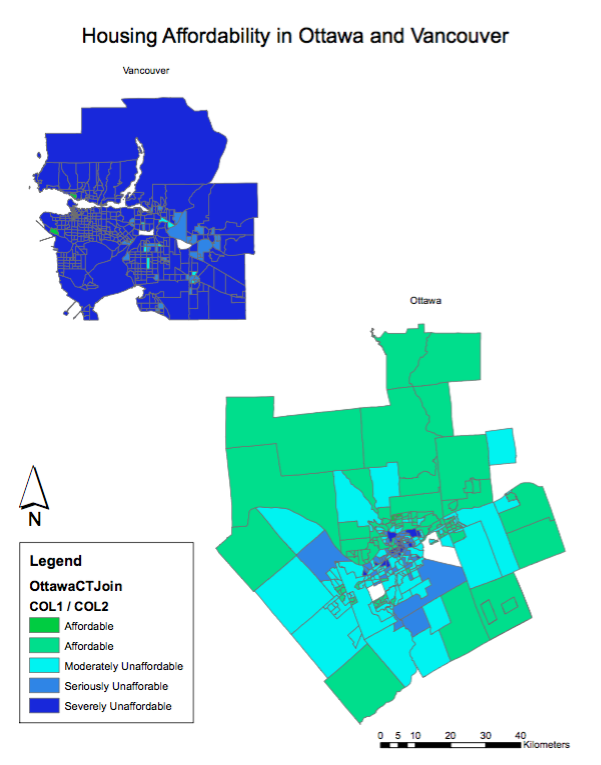
Quantitative Methods Demonstrating Vancouver’s Housing Crisis
Each quantification method highlights a different aspect of the data. The manual breaks show how skewed the market in Vancouver is and highlights the high costs of housing. On the other hand, the equal interval map makes it seem like housing in Vancouver is reasonable and equally distributed. Standard deviation shows a relatively evenly distributed housing market, whereas natural breaks method shows the relative cost of the housing market and demonstrates how expensive the entire city is. Each method pushes the data towards a certain conclusion and therefore shows how data can be manipulated and used to create knowledge.
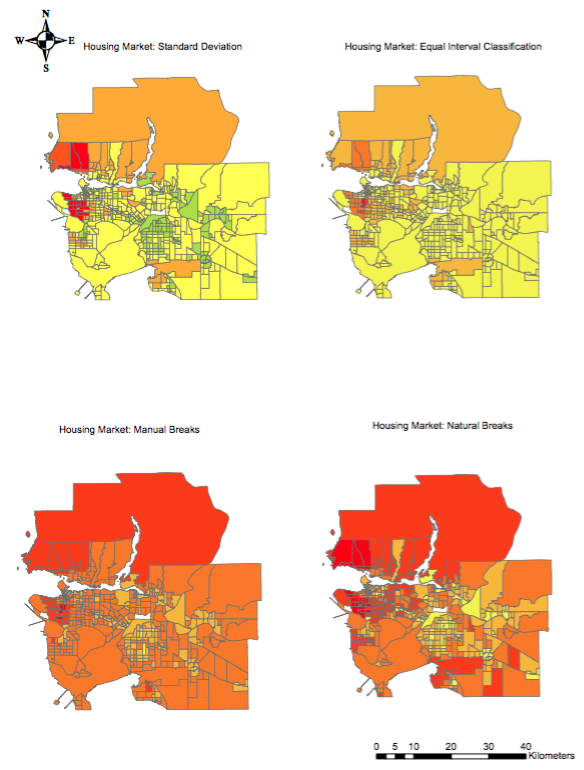
Tsunami Risk in Vancouver
Approximately 15% of all of Vancouver’s land mass is at risk in the event of a tsunami. This percentage was determined by creating a layer for the City of Vancouver and using the attribute table to determine the area of the layer. Then a separate layer was created to illustrate the areas of Vancouver in danger in the event of a tsunami. These areas are either lower than 15m of elevation and within 1 kilometre of the shore. The total area for this layer was also determined and these two numbers were divided to determine the percentage of the city that is at risk to a tsunami.
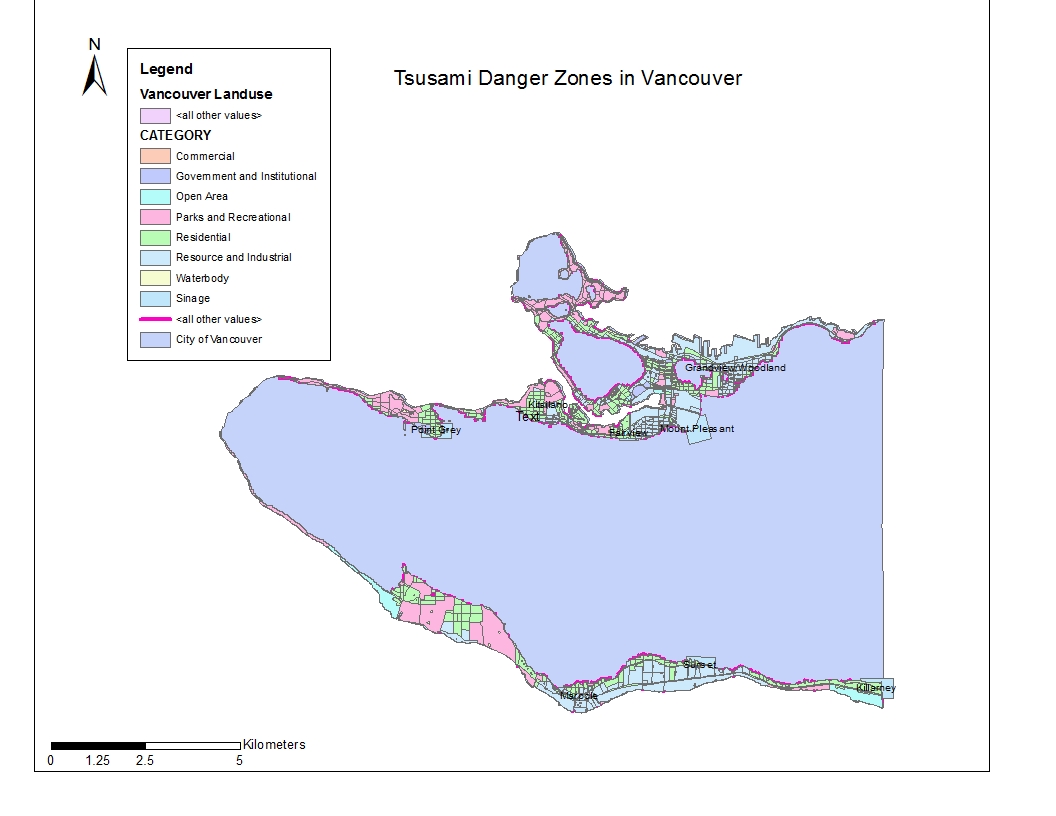
There are certain educational and healthcare facilities that are found within the tsunami risk zone in the City of Vancouver including, but not limited to Point Grey Private Hospital, False Creek Elementary School, and the Royal Canadian College. To determine this, vectors of all the educational and healthcare facilities in Vancouver was added to the map and then intersected with the danger layer to show which facilities are in danger.
ACCOMPLISHMENT STATEMENTS:
Learnt how to combine different layers to create one layer demonstrating a number of aspects.
Expanded knowledge of the social-economic potential of ArcGIS in relation to natural hazards.
Gained experience converting data sets from raster to vector and vice versa and deepened an understanding of the difference between the two.
A Picture is Worth A Thousand References
A number of the sources I used in my research paper had great images, but could not be easily integrated into the paper. To account for that I’ve decided to include the most informative images here along with corresponding parts of the paper. While this is not the full extent of my research paper it offers an introduction through visuals to the topic. 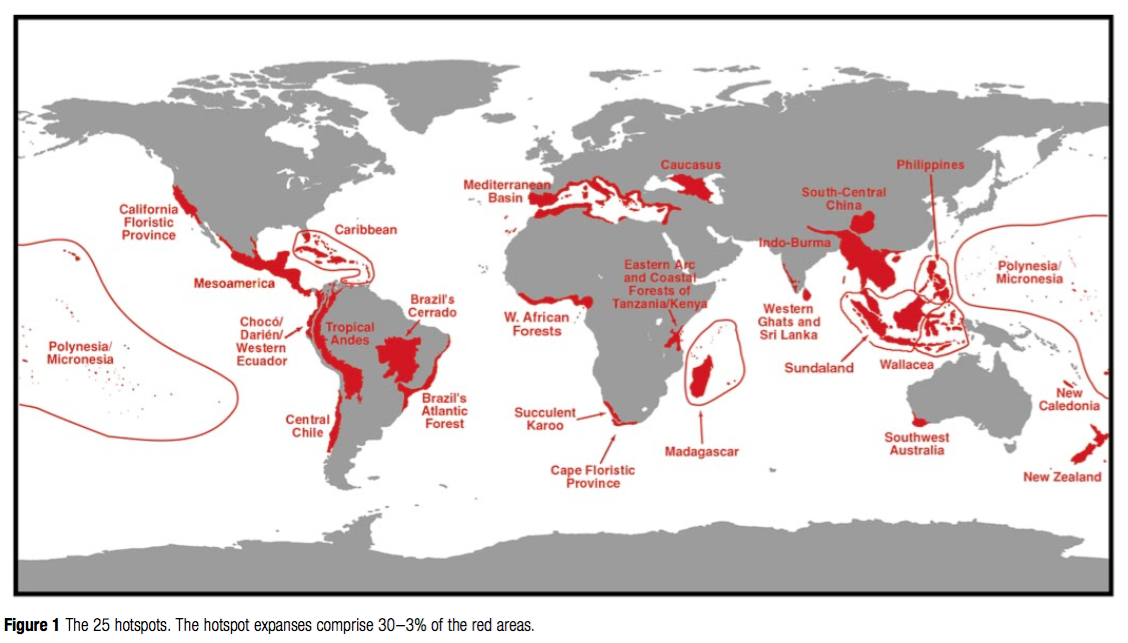 This figure taken from Meyers et al. (2000, p. 853) shows the location of biodiversity hotspots. Hotspots must contain at least 1,500 of the 300,000 plant species and the authors identified 25 hotspots in the world and remarked “sixteen hotspots are in the tropics, which largely means developing countries where threats are greatest and conservation resources are scarcest” (Meyers et. al, 2000, p. 854-55). This clearly demonstrates the important impacts of biodiversity loss on the developing world and shows the need for effective responses. However, biological conservation is not a viable option for many of these hotspots because the cost is high, at an average of $20 million per hotspot per year (Meyers et al., 2000, p. 858). Ecoagriculture offers an alternative as it integrates conservation and production in an effective way.
This figure taken from Meyers et al. (2000, p. 853) shows the location of biodiversity hotspots. Hotspots must contain at least 1,500 of the 300,000 plant species and the authors identified 25 hotspots in the world and remarked “sixteen hotspots are in the tropics, which largely means developing countries where threats are greatest and conservation resources are scarcest” (Meyers et. al, 2000, p. 854-55). This clearly demonstrates the important impacts of biodiversity loss on the developing world and shows the need for effective responses. However, biological conservation is not a viable option for many of these hotspots because the cost is high, at an average of $20 million per hotspot per year (Meyers et al., 2000, p. 858). Ecoagriculture offers an alternative as it integrates conservation and production in an effective way.
The extent to which these hotspots are affected by the human footprint is well-illustrated in another study by Venter et al. (2016, p. 6). This
study shows that 71% of regions had a 20% increase of human pressures (Venter et al, 2016, p. 3). The importance here is to demonstrate that the state of biodiversity differs depending on where it is measured, but overall the status is one of loss (UNEP, 2012, p, 134). According to Venter et al, “the temperate broadleaf forests of Western Europe, eastern United States and China, and the tropical dry forests of India and parts of Brazil, and parts of Southeast Asia’s tropical moist forest” (2016, p. 2) as the areas that will feel the pressures most. However, as stated previously, biodiversity and the rates of loss is not distributed evenly and this will be addressed in relation to the impacts of biodiversity loss and where they are felt.
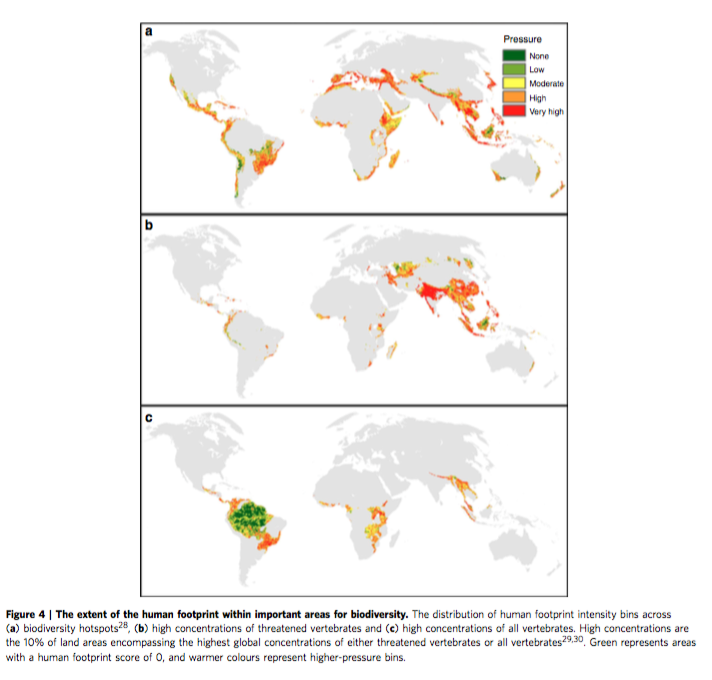
The graphic demonstrates the need for alternative responses. Taken from the GEO5, it shows that although responses have increased they have no yet been effective in slowing biodiversity loss. Reponses to global biodiversity loss have tended to lean towards conservation. While this is the most successful scientific response, it is not the most efficient because countries are reluctant to set aside land for solely preventative purposes. (Brussaard et al., 2010, p. 35). Furthermore, these parcel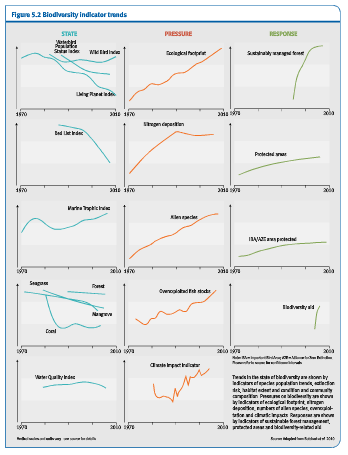 s of land are not being created at a fast enough rate to curb biodiversity loss (UNEP, 2012, p. 135). This demonstrates the demand for another effective response and because agriculture is the primary global driver of habitat loss and consequently biodiversity loss, sustainable agriculture is being closely examined as an effective response. This option is the most efficient because it protects other land from being developed, it decreases the use of chemical pesticides, and increases yield of ecosystem services. Ecoagriculture mixes natural and/or native landscapes and areas of agricultural production. Natural and/or native landscapes are defined as areas with high habitat quality and niches to ensure the survival of critical habitats and ecosystem services (Scherr & McNeely, 2007, p. 480). This technique integrates production and conservation as a response to the global terrestrial biodiversity loss and this is key to responding to biodiversity loss, while continuing to accommodate a growing population (Scherr & McNeely, 2007, p. 485). Agricultural improvement needs to focus on diversification and mixed land uses to accommodate the tradeoffs between agriculture and biodiversity (Brussaard et al., 2010, p. 35).
s of land are not being created at a fast enough rate to curb biodiversity loss (UNEP, 2012, p. 135). This demonstrates the demand for another effective response and because agriculture is the primary global driver of habitat loss and consequently biodiversity loss, sustainable agriculture is being closely examined as an effective response. This option is the most efficient because it protects other land from being developed, it decreases the use of chemical pesticides, and increases yield of ecosystem services. Ecoagriculture mixes natural and/or native landscapes and areas of agricultural production. Natural and/or native landscapes are defined as areas with high habitat quality and niches to ensure the survival of critical habitats and ecosystem services (Scherr & McNeely, 2007, p. 480). This technique integrates production and conservation as a response to the global terrestrial biodiversity loss and this is key to responding to biodiversity loss, while continuing to accommodate a growing population (Scherr & McNeely, 2007, p. 485). Agricultural improvement needs to focus on diversification and mixed land uses to accommodate the tradeoffs between agriculture and biodiversity (Brussaard et al., 2010, p. 35).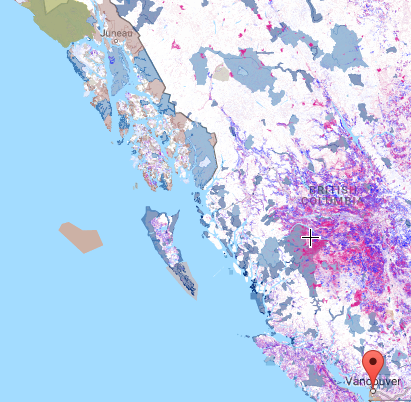
The final image is not taken from a site I used in my research paper, however is an easy-to-use introduction to terrestrial biodiversity and its many components. This site is effective because it allows the user to include as many or as few variable as they life. Below is a screenshot taken showing forest growth and loss, national parks, and hotspots in British Colombia. I think it is an important visual tool that encompasses enough information to make it a useful illustration of biodiversity status today.
References:
Brussaard, L., Caron, P., Campbell, B., Lipper, L., Mainka, S., Rabbinge, R., … Pulleman, M. (2010). Reconciling biodiversity, conservation and food security: scientific challenges for a new agriculture. Current Opinion in Environmental Sustainability, 2, 34-42. doi 10.1016/j.cosust.2010.03.007
Myers, N., Mittermeier, R. A., Mittermeier, C. G. da Fonseca, G. A. B., & Kent, J. (2000). Biodiversity hotspots for conservation priorities. Nature, 403, 853-859.
Scherr, S. J., & McNeely, J. A. (2007) Biodiversity conservation and agricultural sustainability: towards a new paradigm of ‘ecoagriculture’ landscapes. Philosophical Transactions of The Royal Society, 363, 477-494. doi: 10.1098/rstb.2007.2165
United Nations Environment Programme. (2012) GEO 5: Global Environmental Outlook 5. p. 133-167.
Venter, O., Sanderson, E. W., Magrach, A., Allan, J. R., Beher, J., Jones, K. R., … Waston, J. E. M. (2016). Sixteen years of change in the global terrestrial human footprint and implications for biodiversity conservation. Nature Communications, 7,1-11. doi: 10.1038/ncomms12558
Cartography: Tricker than it looks
This is a map of a proposed ski resort just north of Squamish near Garibaldi Park. I chose to include the elevation profile, areas of old growth forest, mammal habitat reach, and river distribution. While this map looks relatively simple, it encompasses two weeks of work. It illustrates that areas that need to be taken into account when planning a project, but to me it shows how cartography is not something to be underestimated. This map is far from perfect and you can see that I’m still learning. However, it is a vast improvement from the first map I made. It makes me proud to look at this map and know that I made it. I also like knowing that there’s lots of room for visible growth in this discipline.
